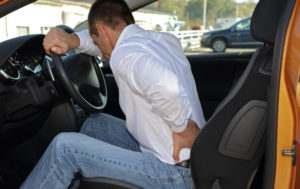Most Common Back Injuries Caused by Car Accidents
 Car accidents put the whole body at risk of injury, from head to toe, but some areas are more vulnerable than others. The spine is both complex and fragile, meaning even the smallest impact can lead to serious injuries and land you at the accident doctor. These injuries can range from minor and easy to treat to severe with lifelong consequences, but treatment will always be critical to healing as much as possible. Below are some of the most common back injuries sustained during an accident and what you need to know if you find yourself diagnosed with these conditions.
Car accidents put the whole body at risk of injury, from head to toe, but some areas are more vulnerable than others. The spine is both complex and fragile, meaning even the smallest impact can lead to serious injuries and land you at the accident doctor. These injuries can range from minor and easy to treat to severe with lifelong consequences, but treatment will always be critical to healing as much as possible. Below are some of the most common back injuries sustained during an accident and what you need to know if you find yourself diagnosed with these conditions.
Vertebrae Fractures
Just like an arm or leg bone may break, the vertebrae in the spine can break, crack, or become damaged. This is actually what is being referenced when you hear that someone has a broken back- at least one of the 33 vertebrae has been broken. Depending on how many vertebrae are affected and how, you may hear an accident doctor refer to different types of fractures, including:
- A burst fracture is when multiple parts of the vertebrae are crushed, potentially causing bone fragments to scatter.
- Flexion fractures occur when the broken vertebra is in the middle or posterior column.
- A compression fracture is a crack or small break in the bone as the result of too much pressure.
- Fracture-dislocation, in which any of the above fractures is combined with the dislocation or movement of the vertebrae.
Sprains and Strains
These terms are often used interchangeably, and while they both deal with soft tissue in the back, they are two distinct injuries.
A strain is when the soft tissue is stretched beyond its normal capacity, causing damage to the tendons in your back. These tendons connect bones to muscles. In contrast, a back strain is damage to the ligaments that connect joints to bones or bones with other bones.
Both strains and sprains can be painful and are not identifiable on diagnostic imaging.
Herniated Discs
Between each vertebra, there are cushiony discs that serve to absorb the shock and prevent bones from rubbing against each other. The impact of a car accident can cause discs to shift outside of their normal location, placing pressure on the surrounding nerves. This is known as a herniated disc, which refers to the inner part of these spinal discs pushing through the outer ring.
You may also hear this called a slipped, bulging, or ruptured disc, but they are generally the same injury. This condition can be extremely painful and cause numbness, a burning sensation, or weakness throughout the body. In severe cases, surgery may be needed to recover fully.
Spondylolisthesis
In some cases of stress fracture, the vertebrae can be moved out of place, compressing nerves or the spinal canal. This causes pain, weakness, and even difficulty walking and is known as spondylolisthesis. Depending on the location of the displacement and the severity, surgery or physical therapy may be options for treatment.
Spinal Stenosis
Spinal stenosis is generally not caused by accidents or other trauma and is instead a degenerative condition. However, many people have asymptomatic cases of spinal stenosis that can be made active by a car accident.
The condition is a narrowing of the spine over time that can cause vertebral height degeneration. The trauma of an accident may make symptoms appear years before they would have naturally and accelerate the speed of the condition.
Facet Joint Injuries
Facet joints sit between a number of spine bones, with nerve roots running through the joints to connect with other body parts like arms and legs. The facet joints help you bend and twist in different directions without causing damage to the spine. When a facet joint is injured, the nerves can be impacted and cause pain. This may be a result of thinning cartilage or previous untreated damage that is brought forth by the impact of an accident. This can cause muscles to tighten and spasm, tenderness in the back, or radiating pain.
Whiplash
One of the most common injuries sustained in car accidents, whiplash is focused on the upper spine and neck. When the head moves backward and forward rapidly, causing strains and tears in the soft tissues of the neck. This can lead to pain and stiffness in the neck and pain that extends to other areas of the spine.
